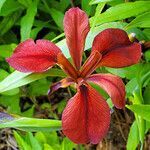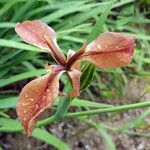Rhizomes compact, greenish brown or sometimes red-tinged, many-branched, with ringlike scars of old leaves, 1.5–2 cm diam. Stems simple or sometimes 1–2-branched, solid, 3–9 dm. Leaves: basal arching distally, blade bright green, lightly ribbed, linear-ensiform, 6–10 dm × 1.5–2.5 cm; cauline subtending branches, blade 4.5–6 dm. Inflorescence units 1–2-flowered; spathes unequal, outer green, 10–12 cm, herbaceous, inner 6–8 cm, partly scarious. Flowers: per-ianth copper colored or reddish brown (yellow in forma fulvaurea); floral tube hollow to ovary, 2–2.5 cm; sepals widely spreading or arching downward, obovate, with 1–3 prominent veins, 4.5–5.5 cm, glabrous, often with lighter yellow basal signal; petals spreading or declining with sepals, 4–5 × 1.5–2 cm, base gradually attenuate, apex deeply emarginate; ovary green, hexagonal, 1.5–1.7 cm; style convex, not keeled, 1.8–2 cm, crests reflexed, rounded-triangular, margins shallowly toothed; stigmas 2-lobed, lobes pointed, margins entire; pedicel 2–4 cm. Capsules remaining green even after seeds mature, oblong-elliptic, hexagonal in cross section, with 6 equally spaced ribs, short beak, 4.5–8 × 2.5 cm. Seeds in 2 rows per locule, irregular, flattened, 10–15 mm, corky. 2n = 42.
More
Lvs ensiform from a horizontal rhizome, 0.5–1 m; stem 0.5–1.5 m, surpassing the lvs; fls 7–9 cm wide, copper-color to brown-orange, reddish-brown, or rarely yellow; tep widely spreading, the claw scarcely a fourth the length of the blade; ovary 6-angled; mature fr 4.5–8 cm, indehiscent; 2n=42. Swamps; s. Ill. and Mo. to Ga. and Pa. Apr., May.
Can be grown by divisions or seedlings. Seeds needs stratification.


